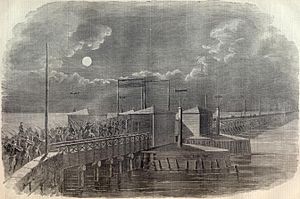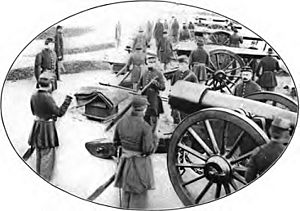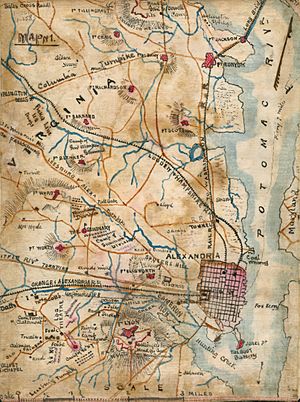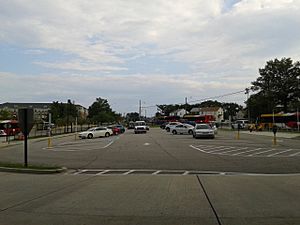Fort Lyon (Virginia) facts for kids
Quick facts for kids Fort Lyon |
|
|---|---|
| Part of the Civil War defenses of Washington, D.C. | |
| Fairfax County, Virginia, USA | |
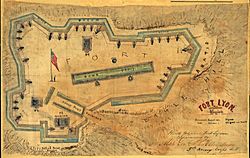
A diagram of Fort Lyon, indicating cannon, magazine, and bombproof locations as well as the overall shape of the fort.
|
|
| Coordinates | 38°47′38″N 77°04′40″W / 38.79389°N 77.07778°W |
| Type | Earthwork fort |
| Site information | |
| Controlled by | Union Army |
| Condition | Dismantled |
| Site history | |
| Built | 1861 |
| Built by | U.S. Army Corps of Engineers |
| In use | 1861–1865 |
| Materials | Earth, timber |
| Demolished | 1865 |
| Battles/wars | American Civil War |
Fort Lyon (sometimes called Camp Lyon in Northern records) was a timber and earthwork fortification built south of Alexandria, Virginia. It was part of the defenses of Washington, D.C. during the American Civil War.
The fort was built quickly after the Union lost the First Battle of Bull Run. Fort Lyon was located on Ballenger's Hill, south of Hunting Creek and Cameron Run. It was near a place called Mount Eagle. From its high spot, the fort could watch over important roads and the Orange and Alexandria Railroad. It protected the southern ways into Alexandria, which was the biggest town in Union-controlled Northern Virginia.
Today, the Huntington Station of the Washington Metro is next to where Fort Lyon used to be. A historical marker at the north end of the station lot reminds people of the fort.
Contents
Why Fort Lyon Was Built
Before the War: Arlington and Washington
Before the Civil War began, Alexandria County (now Arlington County) was mostly farmland. It was very close to Washington, D.C. This land used to be part of Washington, D.C., but it was given back to Virginia in 1847. Most people in the county lived in the city of Alexandria. The rest of the county had farms and a few houses, including Arlington House. This house belonged to Mary Custis, who was the wife of Robert E. Lee.
After Fort Sumter was attacked in April 1861, President Abraham Lincoln said there was a rebellion. He asked for 75,000 soldiers to stop it. This made many Southern states angry, and they started talking about leaving the Union. Virginia decided to vote on whether to secede (leave the Union). The U.S. Army then put all its troops in Washington, D.C., and Maryland under one command.
Protecting Washington, D.C.
Brigadier General Joseph K. Mansfield was in charge of the troops in Washington. He believed that Northern Virginia should be taken over quickly. This would stop the Confederate Army from putting cannons on the hills of Arlington and firing at government buildings in Washington. He also wanted forts built on the Virginia side of the Potomac River. These forts would protect the ends of important bridges like the Chain Bridge and Long Bridge. His leaders agreed, but they waited until Virginia voted on secession.
On May 23, 1861, Virginia voted to leave the Union. That night, U.S. Army troops started crossing the bridges from Washington, D.C., into Virginia. The march began at 10 p.m. and involved many soldiers.
Thousands of soldiers, cavalry, and artillery crossed the Long Bridge. Other troops crossed the Chain Bridge and took control of the high ground there.
Taking over Northern Virginia was mostly peaceful, except in Alexandria. There, Colonel Elmer E. Ellsworth tried to take down a Confederate flag from a hotel. The hotel owner, James Jackson, shot and killed him. Ellsworth was one of the first soldiers to die in the Civil War. Because of this, Alexandria stayed loyal to the Confederacy for much of the war. This meant Union soldiers had to stay there to keep control.
The Battle of Bull Run's Impact
For seven weeks after Northern Virginia was occupied, forts were built along the Potomac River. They also protected the main bridges connecting Virginia to Washington and Georgetown.
While these forts were being built, plans were made for a huge new ring of forts to protect Washington, D.C. These new forts would defend the city from all directions, not just from Arlington. But in mid-July, this work stopped because of the First Battle of Bull Run. Soldiers who were building forts instead marched to battle. After the Union lost at Bull Run, everyone panicked. They quickly built trenches and earthworks to defend Washington from a possible Confederate attack. These defenses were mainly in Arlington and near the direct routes to Washington.
On July 26, 1861, just five days after the battle, Maj. Gen. George B. McClellan became the commander of the Washington military area. When he arrived, McClellan was shocked by how weak the city's defenses were. He said that the city was not ready to stop a strong enemy attack. There were no defenses on the Maryland side, and the enemy could easily shell the city.
To fix this, McClellan ordered a huge expansion of Washington's defenses. Forts and trenches would be built everywhere to stop any attack. Alexandria, with its important port, was a special concern.
Building Fort Lyon
General Horatio Wright and General John Newton oversaw the building of Fort Lyon. They managed the workers and supplies.
Fort Lyon was planned in September 1861. It had a perimeter of about 937 meters (1,025 yards) and covered 9 acres (3.6 hectares). It was surrounded by abatis (a defense made of fallen trees with sharpened branches) and rifle pits (trenches for soldiers to shoot from). The 27th New York Volunteer Infantry Regiment built the fort. It had 31 guns, including four large 200-pounder cannons (8-inch Parrott rifles), and 16 mortars. The fort was named after General Nathaniel Lyon, who died in the Battle of Wilson's Creek in Missouri on August 10, 1861.
Fort Lyon During the War
General Samuel P. Heintzelman was based at Fort Lyon when he was in charge of Washington's defense from October 1862 to October 1863. Robert Knox Sneden also worked there on his staff for a few months in 1862.
On June 9, 1863, a huge black powder explosion shook Fort Lyon. Twenty-five soldiers died, and eight tons of powder and thousands of rounds of ammunition were destroyed. The explosion was so loud that people in nearby Alexandria heard it. One witness said the earth shook and trembled. They described Fort Lyon going up with a "tremendous shock," looking like a volcano erupting. Pieces of steel, stones, and dirt rained down afterward.
After the explosion, many important people visited Fort Lyon and Alexandria. These included Secretary of War Edwin M. Stanton and President Abraham Lincoln.
Different groups of soldiers were stationed at Fort Lyon over time. These included the 16th New York Volunteer Infantry Regiment, 26th New York Volunteer Infantry Regiment, 27th New York Volunteer Infantry Regiment, 107th New York Volunteer Infantry, 142nd Ohio Infantry, and the 15th New York Heavy Artillery Regiment. In October 1864, parts of the 1st Wisconsin Heavy Artillery Regiment were assigned to the fort. They left the army in June 1865.
After the War
Today, nothing remains of Fort Lyon. Only a historical marker shows where it once stood. This marker was put up in 1998 by the Virginia Department of Historic Resources. It is located at the north end of the King's Highway parking area of the Huntington Metro station.
- U.S. National Park Service Historic Resource Study of the Civil War defenses of Washington, D.C.


